Ciao a Tutti! 😀
The holidays are coming to an end, and we all know that it is that time of
the year that everybody hates: starting a diet!
 What better way to do this than by reading what I’ve cooked for Christmas Eve? It’s way healthier and … better than any other diets! 😉
What better way to do this than by reading what I’ve cooked for Christmas Eve? It’s way healthier and … better than any other diets! 😉
Winter Break arrived so quickly for all of us – college/university students and workers – and some of us don’t have a place to stay, so we either fly back to our hometowns or ask some friends to have us for a while in their houses. Thankfully, I have great friends, because that’s what I chose to do.

My first stop was at my friend Jeremy’s house in Boston – I love that city, and who knows, maybe one day I’ll live there. So, at Jeremy’s I found a beautiful and loving family that welcomed me in such a caring way that I actually felt at home! His mother, Sara, was the one I spent the most time with because of our similar lifestyle: we wake up early! lol But also because we spent a lot of time together cooking, she indeed is my guest for today’s post!
I don’t know if you know this, but in Italy we have three important days dedicated to eating for Christmas: the 24th’s Dinner, the 25th’s Lunch, and the 26th’s Lunch – there is also the 27th but that’s “leftovers Day”! So, Sara and I decided that for Christmas Eve, we would cook Italian pasta and sauce, both homemade of course!
So, to begin we started making the tomato sauce (the original Italian one):
Ingredients
Extra virgin olive oil
1 bunch fresh basil , leaves picked and torn
4 lbs of good-quality tomatoes
3 carrots
2/3 garlic cloves (or onions)
3 stalks of celery
salt
Method
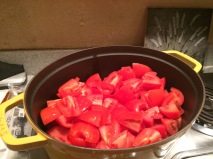 Wash, core, and cut tomatoes into small pieces. Then, place them in a large pot. Now heat the tomatoes over medium. After about 15 minutes give the tomatoes a stir and keep stirring once in a while until all the tomatoes are reduced to a mush. Now, smash all tomatoes with a mixer until it becomes slightly creamy, but not to the point of liquidation. Now, it’s time to pour 3 spoons of oil i
Wash, core, and cut tomatoes into small pieces. Then, place them in a large pot. Now heat the tomatoes over medium. After about 15 minutes give the tomatoes a stir and keep stirring once in a while until all the tomatoes are reduced to a mush. Now, smash all tomatoes with a mixer until it becomes slightly creamy, but not to the point of liquidation. Now, it’s time to pour 3 spoons of oil i nto a pot, add very well minced celery, carrots, and onions, but if you have kids and they don’t like to see “things” in the sauce, you can actually chop carrots and celery stalks in big pieces so that you can remove them once everything is cooked – you can also use garlic cloves instead of onions if you prefer or have allergies and similar problems. Once it becomes brown (not too much, a few minutes are enough), pour the sauce into the pot, add a pinch of salt, stir, and let cook until the sauce is to your desired consistency. Then, remove from heat and add some FRESH basil leaves and stir. Salt to taste, if it isn’t salty enough.
nto a pot, add very well minced celery, carrots, and onions, but if you have kids and they don’t like to see “things” in the sauce, you can actually chop carrots and celery stalks in big pieces so that you can remove them once everything is cooked – you can also use garlic cloves instead of onions if you prefer or have allergies and similar problems. Once it becomes brown (not too much, a few minutes are enough), pour the sauce into the pot, add a pinch of salt, stir, and let cook until the sauce is to your desired consistency. Then, remove from heat and add some FRESH basil leaves and stir. Salt to taste, if it isn’t salty enough.
I know, many of you will be like:

I did write a lot of “few” instead of exact quantities or timings, but this is the way I learned and I can tell by just seeing it so I don’t know how to specify it better!
Now, while our sauce was cooking, we started preparing the dough for our ravioli and sagne!
Ingredients
0.55 lbs of flour
2 eggs
1 yolk
salt
Method
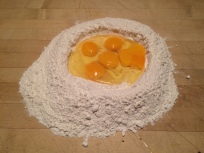
Pour the flour and make a sort of fountain, break the eggs inside (do not throw the white of the egg away, we might need it later), and start mashing everything together with your hands. It may be gross for some of you but believe me this is the most ancient, natural, and funny way to do it. If the dough is not elastic, add some warm water to make it more tender. On the contrary, if it is too sticky, sparingly add some flour. So, when the dough is homogenous and smooth, turn it into a ball. Put it into a bowl and cover it with cellophane or with a towel. Let it rest for about 30 minutes in a dark and dry place. Now, while the dough is resting, we need to take care of the filling: usually it is made of spinach and ricotta but we also did one with just ricotta – the procedure is the same, just do not add the spinach, easy. 😉
Ingredients
0.55 lbs of fresh spinach leaves
0.55 lbs of ricotta
0.11 lbs of Parmesan
nutmeg
Pepper
salt
Method
In a 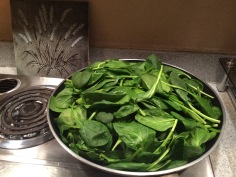 pan, put the spinach leaves, heat over medium and let them cook, covering them until they are soft. Once cooked, drain them until they loose the water. Now, in a bowl, mix the ricotta with the Parmesan, a pitch of nutmeg, salt, and pepper. Mince the spinach leaves, and add them to the bowl. Mix.
pan, put the spinach leaves, heat over medium and let them cook, covering them until they are soft. Once cooked, drain them until they loose the water. Now, in a bowl, mix the ricotta with the Parmesan, a pitch of nutmeg, salt, and pepper. Mince the spinach leaves, and add them to the bowl. Mix.
And now the fun part begins: take the dough and roll and stretch it with a rolling pin. We had a problem with this step because usually to make ravioli we need a pasta machine, but unfortunately few American families have one! So, with some elbow grease, you might have the same results … we didn’t. But still, we had a lot of fun by simply making all the family members try doing it! It doesn’t matter. You can still make ravioli, and while they won’t be perfect, they will still be tasty, and that’s what matters.
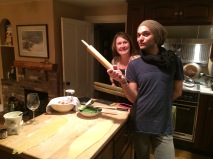
Now, stretch out the the pieces of dough into the most rectangular shape you can make. You will have many rectangular pieces.
Take the filling and spoon some onto the dough, repeating this step as long as there’s space on the dough. Be careful though, as there must be enough space from both the balls of filling and the borders to fold them. It’s really complicated to explain but not to actually do it! 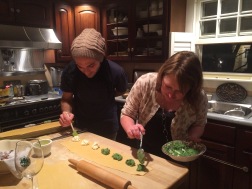 The picture below will help for sure! Once you can manage to create these little balls on the dough, you need to brush the borders with either the white of the egg you didn’t use or with some water in order to avoid the ravioli are unfolding in the boiling water while they are cooking. Now, take the longest edge of the rectangular dough (the farthest from the filling) and fold it so it meets the other perfectly. With two fingers, make sure to let the air out around the balls of filing.
The picture below will help for sure! Once you can manage to create these little balls on the dough, you need to brush the borders with either the white of the egg you didn’t use or with some water in order to avoid the ravioli are unfolding in the boiling water while they are cooking. Now, take the longest edge of the rectangular dough (the farthest from the filling) and fold it so it meets the other perfectly. With two fingers, make sure to let the air out around the balls of filing.
Once they are all ready and cooked, put them in large bowl – or wherever you want to serve them from – and pour the sauce on them, enough to make them red. Sprinkle parmesan on top and voila: ready to eat! 
My assistant, Sara, and I also had some extra dough, so we decided to make a quicker type of pasta, my region’s speciality: Sagne – just so you know ravioli and sagne are plural nouns already, no ending -s needed! Their dough is usually made of just water, flour, and salt, but you can also do it with the ravioli’s dough.
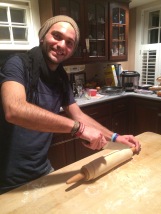 The preparation is really easy to do. Just roll the dough into a circular thin shape and once it’s done, roll it on the rolling pin. Cut on top of it with a knife so that you have perfect rectangular-shaped pieces of dough, one on top of the other. Now, cut them into small little strings.
The preparation is really easy to do. Just roll the dough into a circular thin shape and once it’s done, roll it on the rolling pin. Cut on top of it with a knife so that you have perfect rectangular-shaped pieces of dough, one on top of the other. Now, cut them into small little strings.
Once you manage to cut all of them, with your hands grab them all and mix them a little. The pictures may help!
Now, you have to follow the same steps that we did for the ravioli in order to cook them and add the sauce! And again, ready to eat! 😀
Always serve pasta with bread, please! Italians love to do the SCARPETTA! When you finish eating “pasta al sugo” or anything with sauce, the act of using the bread to “clean up the plate” is called scarpetta.
Hope you had beautiful holidays, and if you didn’t make some homemade pasta or cook, it’s always relaxing and gratifying! 😀
Sara and I having some fun the following day (on Christmas Day). We made a cheesy Christmas tree and “bruschette” that by the way is a plural noun and it’s not the topping but the toasted bread! 😉
Thank you Pozner family for hosting me!
PS: If you want to check some other interesting recipes written in English to surprise your guests or thank your hosts as I did, take a look a this website. There are a lot of fancy recipes that are also presented as gifts, so maybe it will give you few ideas for next Christmas or for some other holidays or birthdays!







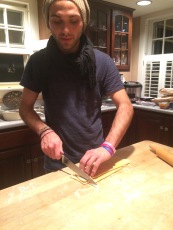







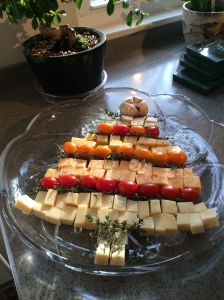

 YouTube and in less than 24 hours, my students, other Italian students and my friends in Italy posted this video on Facebook profile at the same time – I had at least 10 same videos. Before I could actually watch it,
YouTube and in less than 24 hours, my students, other Italian students and my friends in Italy posted this video on Facebook profile at the same time – I had at least 10 same videos. Before I could actually watch it,  another one. I was overwhelmed by so many posts. Anyway, I managed to delete all the extras on my FB profile and watched the original and
another one. I was overwhelmed by so many posts. Anyway, I managed to delete all the extras on my FB profile and watched the original and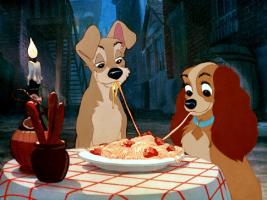
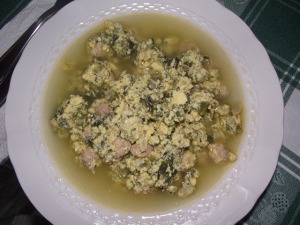
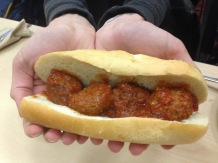

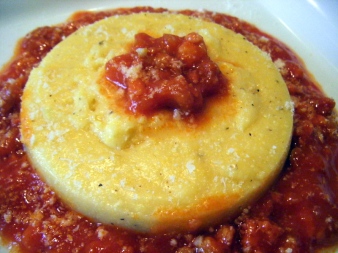



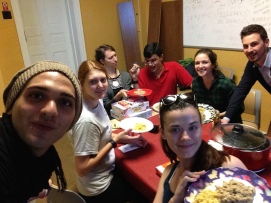


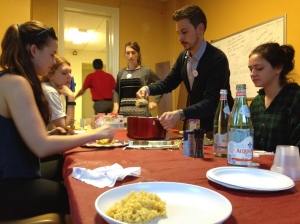

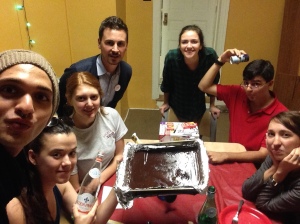
 t!
t!